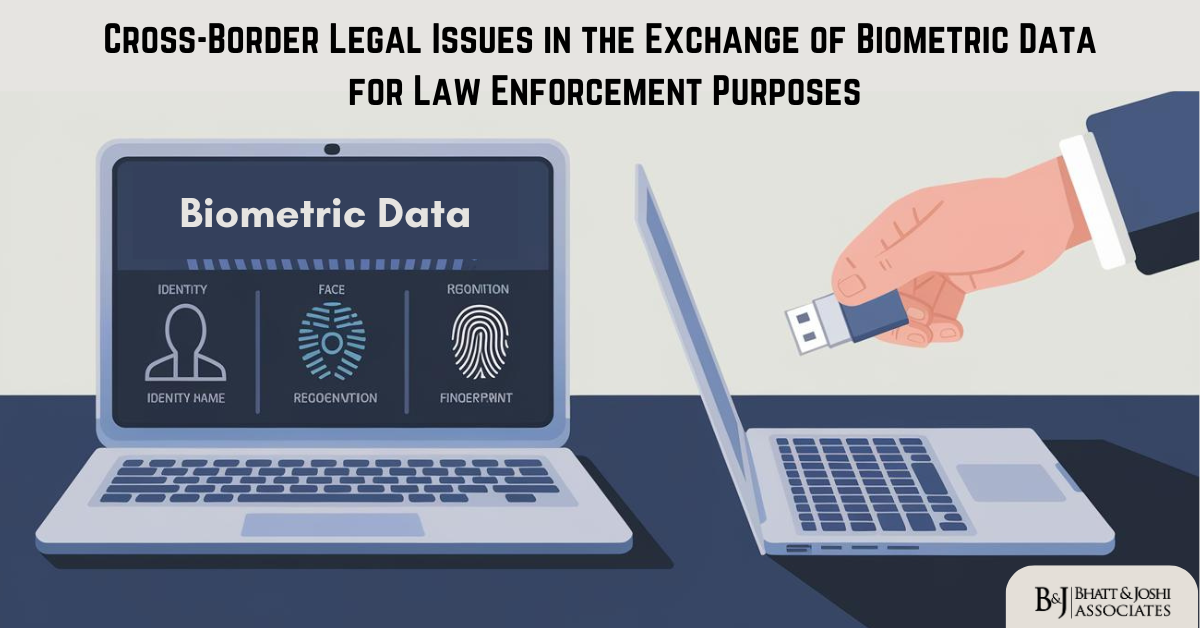
Introduction
The exchange of biometric data across borders for law enforcement purposes is increasingly becoming a vital tool in combating transnational crime, terrorism, and other serious threats to global security. As biometric technologies such as fingerprinting, facial recognition, and DNA analysis become more advanced and widespread, law enforcement agencies around the world are turning to biometric data to enhance their investigative capabilities and improve identification processes. However, the cross-border exchange of biometric data also raises significant legal challenges, particularly in the areas of data protection, privacy, human rights, and international cooperation.
This article provides a comprehensive analysis of the cross-border legal issues associated with the exchange of biometric data for law enforcement purposes. It explores the legal frameworks governing the collection, transfer, and use of biometric data across different jurisdictions, the challenges posed by conflicting laws and standards, and the potential risks to individual rights. The article also examines the role of international agreements and institutions in facilitating the exchange of biometric data while safeguarding fundamental rights and the rule of law.
The Growing Importance of Biometric Data in Law Enforcement
Biometric data has emerged as a powerful tool in law enforcement, offering a more accurate and reliable means of identifying individuals compared to traditional methods such as photographs or identity documents. Biometric identifiers, which include fingerprints, facial images, iris patterns, and DNA profiles, are unique to each individual and remain consistent over time, making them ideal for identification and verification purposes.
Law enforcement agencies use biometric data for a wide range of purposes, including criminal investigations, border security, and counterterrorism. For example, fingerprints collected at crime scenes can be compared against national and international databases to identify suspects or link individuals to multiple crimes. Facial recognition technology can be used to identify individuals captured on surveillance cameras or to verify the identity of individuals crossing borders. DNA analysis can be employed to solve cold cases, identify missing persons, or establish familial relationships in criminal investigations.
The effectiveness of biometric data in law enforcement is enhanced when it is shared across borders. Transnational crime, including human trafficking, drug smuggling, and terrorism, often involves individuals who move between countries to evade detection. By sharing biometric data, law enforcement agencies can track the movements of suspects, identify individuals who use multiple identities, and collaborate on joint investigations. However, the cross-border exchange of biometric data is not without legal and ethical challenges.
Legal Frameworks Governing Cross-Border Exchange of Biometric Data
The legal frameworks governing the exchange of biometric data for law enforcement purposes vary significantly across different jurisdictions. These frameworks are shaped by national laws, international agreements, and regional regulations, each with its own set of rules and standards. One of the primary challenges in the cross-border exchange of biometric data is the need to navigate these diverse legal landscapes while ensuring compliance with domestic and international obligations.
In the European Union, the General Data Protection Regulation (GDPR) provides a comprehensive legal framework for the protection of personal data, including biometric data. The GDPR imposes strict requirements on the processing of biometric data, classifying it as a special category of personal data that requires enhanced protection. Under the GDPR, the transfer of personal data, including biometric data, to countries outside the European Economic Area (EEA) is only permitted if the receiving country provides an adequate level of data protection, as determined by the European Commission, or if appropriate safeguards, such as standard contractual clauses or binding corporate rules, are in place.
The GDPR also includes provisions specifically addressing the processing of personal data for law enforcement purposes. The Law Enforcement Directive (LED), which complements the GDPR, sets out the rules for the processing of personal data by competent authorities for the purposes of the prevention, investigation, detection, or prosecution of criminal offenses. The LED requires that the transfer of personal data to third countries for law enforcement purposes must be necessary and proportionate to the legitimate aim pursued and must include appropriate safeguards to protect the rights of individuals.
In the United States, the legal framework for the exchange of biometric data for law enforcement purposes is more fragmented, with a combination of federal and state laws governing the collection, use, and sharing of biometric data. At the federal level, the Department of Justice (DOJ) and the Federal Bureau of Investigation (FBI) play key roles in managing biometric data through systems such as the Integrated Automated Fingerprint Identification System (IAFIS) and the Next Generation Identification (NGI) system. These systems allow for the sharing of biometric data with other federal agencies, state and local law enforcement, and international partners. The sharing of biometric data with foreign entities is subject to various legal restrictions, including the requirement that such transfers be conducted in accordance with international agreements and treaties.
Internationally, the exchange of biometric data for law enforcement purposes is often governed by bilateral or multilateral agreements between countries. For example, the United States and the European Union have entered into several agreements that facilitate the exchange of biometric data for law enforcement purposes, such as the U.S.-EU Data Protection and Privacy Agreement (DPPA) and the U.S.-EU Passenger Name Record (PNR) Agreement. These agreements establish the legal framework for data sharing while setting out specific safeguards to protect the privacy and rights of individuals.
Challenges Posed by Conflicting Laws and Standards
One of the most significant challenges in the cross-border exchange of biometric data for law enforcement purposes is the potential for conflicts between different legal regimes. Countries have varying standards for data protection, privacy, and human rights, which can create legal and operational challenges when exchanging biometric data across borders.
For example, the GDPR imposes stringent requirements on the processing and transfer of personal data, including the requirement that transfers to third countries must ensure an adequate level of protection. However, many countries outside the EEA do not have data protection laws that meet the GDPR’s standards, creating a legal barrier to the transfer of biometric data from the EU to these countries. This can hinder international cooperation on law enforcement and counterterrorism efforts.
Similarly, differences in legal standards for the use of biometric data in criminal investigations can create challenges in cross-border cases. For instance, some countries may have stricter rules on the admissibility of biometric evidence in court, while others may have more lenient standards. These differences can complicate the sharing of biometric data and the coordination of joint investigations, particularly when the data is intended to be used as evidence in criminal proceedings.
Another challenge arises from the differing approaches to privacy and data protection in law enforcement. While some countries prioritize the protection of individual privacy, others may place a greater emphasis on national security and public safety. These differing priorities can lead to conflicts over the scope and purpose of biometric data sharing, as well as the conditions under which data can be accessed and used by law enforcement agencies.
The Impact of International Agreements and Institutions
International agreements and institutions play a critical role in facilitating the cross-border exchange of biometric data for law enforcement purposes while safeguarding fundamental rights and the rule of law. These agreements establish the legal framework for data sharing, set out the conditions under which data can be transferred, and provide mechanisms for oversight and accountability.
One of the key international agreements governing the exchange of biometric data is the U.S.-EU Data Protection and Privacy Agreement (DPPA). The DPPA, which came into effect in 2016, provides a legal framework for the transfer of personal data, including biometric data, between the United States and the European Union for law enforcement purposes. The agreement sets out specific safeguards to protect the privacy and rights of individuals, including the requirement that data transfers be conducted in a manner that is necessary and proportionate to the legitimate aim pursued. The DPPA also establishes mechanisms for redress and oversight, allowing individuals to seek legal remedies if their rights are violated.
Another important international agreement is the U.S.-EU Passenger Name Record (PNR) Agreement, which governs the transfer of passenger name records, including biometric data, between the United States and the European Union for the purposes of preventing and combating terrorism and serious transnational crime. The PNR Agreement includes provisions to ensure that data transfers are subject to strict data protection standards, including limitations on the retention and use of the data, as well as requirements for transparency and oversight.
International institutions such as INTERPOL and Europol also play a vital role in facilitating the exchange of biometric data for law enforcement purposes. INTERPOL, the International Criminal Police Organization, operates several biometric databases that are accessible to law enforcement agencies around the world. These databases include the INTERPOL Fingerprints Database, the INTERPOL DNA Database, and the INTERPOL Facial Recognition System. Europol, the European Union Agency for Law Enforcement Cooperation, also manages databases that contain biometric data, which can be shared with member states and third countries under certain conditions.
While these international agreements and institutions provide a framework for the exchange of biometric data, they also raise important questions about accountability, oversight, and the protection of individual rights. For example, the use of biometric data in international databases may lead to concerns about the potential for data breaches, misuse of data, and violations of privacy. Ensuring that these risks are adequately addressed requires robust legal safeguards, transparency, and independent oversight.
Human Rights Considerations in the Cross-Border Exchange of Biometric Data
The cross-border exchange of biometric data for law enforcement purposes raises significant human rights concerns, particularly in relation to the right to privacy, the right to a fair trial, and the protection against arbitrary detention and torture. These concerns are heightened when biometric data is shared with countries that have weak legal protections for human rights or that engage in practices such as torture, arbitrary detention, or political persecution.
One of the primary human rights concerns is the potential for biometric data to be used in ways that violate the right to privacy. The right to privacy is enshrined in international human rights instruments such as the Universal Declaration of Human Rights (Article 12) and the International Covenant on Civil and Political Rights (Article 17). The collection, storage, and sharing of biometric data without adequate safeguards can result in unwarranted intrusions into individuals’ private lives and may lead to abuses such as surveillance, profiling, and discrimination.
Another critical human rights issue is the potential misuse of biometric data in ways that undermine the right to a fair trial. The right to a fair trial, protected under Article 14 of the International Covenant on Civil and Political Rights (ICCPR), includes the right to be presumed innocent until proven guilty, the right to legal representation, and the right to challenge evidence presented in court. When biometric data is shared across borders, there is a risk that it may be used in criminal proceedings without the individual being given an opportunity to contest the accuracy or legality of the data collection. This is particularly concerning in jurisdictions where due process protections are weak or where the legal system may be prone to corruption or political influence.
The use of biometric data in law enforcement also raises concerns about protection against arbitrary detention and torture. When biometric data is shared with countries that have a history of human rights abuses, there is a risk that individuals may be detained, interrogated, or subjected to torture based on biometric evidence that may be flawed, inaccurate, or obtained without proper legal safeguards. For example, if an individual is wrongly identified by facial recognition technology as a suspect in a criminal investigation, they could be detained and subjected to harsh treatment in a country where the rule of law is not respected.
To address these human rights concerns, international agreements governing the cross-border exchange of biometric data often include specific safeguards to protect individuals’ rights. These safeguards may include provisions requiring that data transfers be subject to judicial or administrative oversight, that individuals be notified when their biometric data is shared with a foreign country, and that there are mechanisms in place to challenge the use of biometric data in legal proceedings. Additionally, international human rights bodies, such as the United Nations and regional organizations like the European Court of Human Rights, play a crucial role in monitoring and enforcing these protections.
The Role of Data Protection Authorities and Oversight Mechanisms
Effective oversight and accountability are essential to ensuring that the cross-border exchange of biometric data for law enforcement purposes is conducted in a manner that respects individuals’ rights and complies with legal and ethical standards. Data protection authorities (DPAs) and other oversight bodies play a critical role in this process by monitoring compliance with data protection laws, investigating complaints, and enforcing sanctions for violations.
In the European Union, each member state has its own DPA responsible for enforcing the GDPR and the Law Enforcement Directive. These authorities have the power to investigate cases of non-compliance, issue fines, and order the suspension of data transfers that do not meet the required standards of data protection. The European Data Protection Board (EDPB), an independent body composed of representatives from the national DPAs, provides guidance on the interpretation and application of the GDPR and the LED, and can issue binding decisions in cases of cross-border data transfers.
In addition to DPAs, other oversight mechanisms may include independent judicial bodies, parliamentary committees, and ombudsmen. These institutions provide an additional layer of accountability by ensuring that law enforcement agencies and other entities involved in the exchange of biometric data are acting within the bounds of the law and respecting the rights of individuals. For example, in the United States, the Privacy and Civil Liberties Oversight Board (PCLOB) provides oversight of executive branch policies and procedures to ensure that they protect privacy and civil liberties, particularly in the context of counterterrorism and national security.
However, the effectiveness of these oversight mechanisms can vary depending on the legal and political context in which they operate. In some countries, DPAs may lack the resources, independence, or authority to effectively enforce data protection laws, particularly when faced with powerful law enforcement agencies or national security interests. Similarly, judicial and parliamentary oversight may be limited in jurisdictions where the judiciary is not fully independent or where there is a lack of transparency and accountability in government decision-making.
Challenges and Risks of Cross-border Exchange of Biometric Data
The cross-border exchange of biometric data for law enforcement purposes presents several challenges and risks that must be carefully managed to ensure that data transfers are conducted in a manner that respects individuals’ rights and complies with legal obligations.
One of the primary challenges is ensuring that data protection standards are maintained across different jurisdictions. As previously mentioned, countries have varying levels of data protection, and the legal frameworks governing the use of biometric data may differ significantly from one country to another. This creates a risk that biometric data shared with a foreign country may be subject to lower levels of protection, increasing the likelihood of misuse, unauthorized access, or data breaches.
To mitigate this risk, international agreements often include provisions that require the receiving country to provide an adequate level of data protection, as determined by the sending country or an international body. For example, the GDPR allows for the transfer of personal data, including biometric data, to third countries only if they provide an adequate level of protection, as determined by the European Commission. In cases where the receiving country does not meet this standard, data transfers may still be permitted if appropriate safeguards are in place, such as standard contractual clauses or binding corporate rules.
Another challenge is the risk of data breaches and unauthorized access to biometric data. Biometric data is highly sensitive, and its compromise can have serious consequences for individuals, including identity theft, wrongful arrest, or targeted surveillance. When biometric data is shared across borders, it may be stored or processed in jurisdictions with weaker cybersecurity protections, increasing the risk of data breaches. Additionally, the transfer of biometric data over international networks can create opportunities for interception or hacking by malicious actors.
To address these risks, law enforcement agencies and other entities involved in the exchange of biometric data must implement robust security measures to protect the data throughout its lifecycle. This may include encryption, secure data transfer protocols, regular security audits, and incident response plans in the event of a data breach. Additionally, international agreements may include provisions requiring the receiving country to adopt specific security measures to protect the data and to notify the sending country and affected individuals in the event of a data breach.
A further challenge is ensuring that individuals have access to effective remedies in the event that their rights are violated as a result of the cross-border exchange of biometric data. This may include the right to be informed when their biometric data is shared with a foreign country, the right to access and correct their data, and the right to seek redress if their data is misused or if they are subjected to unlawful surveillance or detention based on biometric data. However, accessing these remedies can be difficult, particularly when the data is transferred to a country with weak legal protections or where the individual has limited recourse to legal action.
The Need for International Cooperation and Harmonization
Given the complex legal and ethical challenges associated with the cross-border exchange of biometric data for law enforcement purposes, there is a growing recognition of the need for greater international cooperation and harmonization of legal standards. By developing common frameworks and standards for the collection, use, and transfer of biometric data, countries can enhance their ability to collaborate on transnational law enforcement efforts while ensuring that individual rights are protected.
One approach to achieving greater harmonization is through the development of international standards and guidelines for the use of biometric data in law enforcement. Organizations such as the International Organization for Standardization (ISO) and the International Criminal Police Organization (INTERPOL) have been instrumental in developing technical standards and best practices for biometric data collection, storage, and sharing. These standards provide a common framework for countries to follow, helping to ensure that biometric data is handled consistently and securely across borders.
In addition to technical standards, there is also a need for legal and regulatory harmonization. This may involve the negotiation of bilateral or multilateral agreements that establish common legal standards for the exchange of biometric data, as well as mechanisms for oversight and accountability. For example, the Council of Europe’s Convention 108+ is an international treaty that aims to harmonize data protection standards across its member states, including provisions specifically related to the processing of biometric data. By ratifying such agreements, countries can create a more consistent and predictable legal environment for the exchange of biometric data, reducing the risk of conflicts and enhancing cooperation.
Another important aspect of international cooperation is capacity building and technical assistance. Many countries, particularly in the developing world, may lack the resources, expertise, or infrastructure to effectively manage biometric data and comply with international data protection standards. Providing technical assistance and capacity-building support can help these countries strengthen their data protection frameworks, improve cybersecurity, and enhance their ability to participate in international law enforcement cooperation.
Ethical Considerations and Public Trust
Beyond the legal challenges, the cross-border exchange of biometric data for law enforcement purposes also raises important ethical considerations. The use of biometric data in law enforcement touches on fundamental questions of privacy, autonomy, and the balance between security and individual rights. As such, it is essential that the exchange of biometric data is conducted in a manner that is not only legally compliant but also ethically sound and respectful of human dignity.
One of the key ethical concerns is the potential for the misuse of biometric data in ways that could harm individuals or groups. This includes the risk of wrongful identification, where an individual is mistakenly identified as a suspect based on flawed or inaccurate biometric data. Such errors can have devastating consequences, including wrongful arrest, detention, or even extradition. Ensuring the accuracy and reliability of biometric systems is therefore not only a technical challenge but also an ethical imperative.
Another ethical issue is the potential for discrimination and bias in the use of biometric data. As mentioned earlier, biometric technologies, such as facial recognition, have been shown to exhibit biases based on race, gender, and other characteristics. These biases can lead to disproportionate targeting of certain groups, contributing to systemic discrimination and inequality. It is essential that law enforcement agencies and technology providers take steps to identify and mitigate these biases, ensuring that biometric data is used fairly and equitably.
Transparency and public trust are also critical ethical considerations. The cross-border exchange of biometric data involves the processing of highly sensitive personal information, and it is essential that individuals have confidence that their data is being handled responsibly and in accordance with the law. This requires transparency on the part of law enforcement agencies and governments, including clear communication about the purposes of biometric data collection, the legal basis for data transfers, and the safeguards in place to protect individual rights.
Engaging with the public and civil society organizations is also important for building trust and ensuring that the use of biometric data in law enforcement is aligned with societal values and expectations. Public consultations, impact assessments, and ongoing dialogue with stakeholders can help to identify potential risks and concerns, as well as to develop policies and practices that are responsive to the needs and rights of individuals.
Key Takeaways on Cross-border Biometric Data Exchange
The cross-border exchange of biometric data for law enforcement purposes presents both significant opportunities and complex legal challenges. While biometric data offers powerful tools for identifying individuals, solving crimes, and enhancing security, its cross-border exchange must be carefully managed to ensure that it complies with legal standards, respects human rights, and addresses ethical concerns.
Navigating the diverse legal frameworks that govern the use and transfer of biometric data across different jurisdictions is a key challenge for law enforcement agencies and policymakers. Conflicting laws and standards, as well as the varying levels of data protection in different countries, can create legal barriers to effective cooperation and raise concerns about the protection of individual rights.
To address these challenges, there is a growing need for greater international cooperation and harmonization of legal standards. By developing common frameworks, standards, and agreements, countries can enhance their ability to collaborate on transnational law enforcement efforts while ensuring that biometric data is handled securely, fairly, and transparently.
Moreover, ethical considerations must be at the forefront of discussions about the use of biometric data in law enforcement. Ensuring the accuracy and fairness of biometric systems, protecting against misuse and discrimination, and maintaining public trust are all essential components of a responsible and ethical approach to biometric data exchange.
As biometric technologies continue to evolve and become more integrated into law enforcement practices, it is essential that legal and ethical considerations remain at the center of the conversation. By striking the right balance between security and individual rights, and by fostering international cooperation and accountability, we can harness the benefits of biometric data while safeguarding the fundamental rights and freedoms that are the cornerstone of democratic societies.













